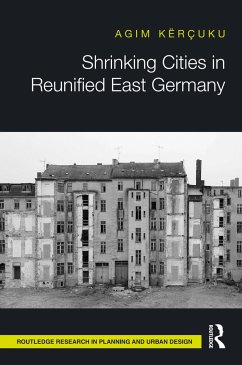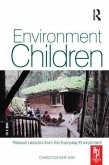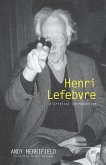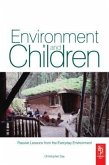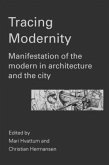Agim Kërçuku
Shrinking Cities in Reunified East Germany
Agim Kërçuku
Shrinking Cities in Reunified East Germany
- Gebundenes Buch
- Merkliste
- Auf die Merkliste
- Bewerten Bewerten
- Teilen
- Produkt teilen
- Produkterinnerung
- Produkterinnerung
The book explores the relationship between the shrinking process and architecture and urban design practices. Starting from a journey in former East Germany, six different scenes are explored in which plans, projects, and policies have dealt with shrinkage since the 1990s.
Andere Kunden interessierten sich auch für
![Heidegger for Architects Heidegger for Architects]() Adam SharrHeidegger for Architects134,99 €
Adam SharrHeidegger for Architects134,99 €![Primitive Primitive]() Samuel Flora / Jo Odgers / Adam Sharr (eds.)Primitive218,99 €
Samuel Flora / Jo Odgers / Adam Sharr (eds.)Primitive218,99 €![Environment and Children Environment and Children]() Christopher DayEnvironment and Children167,99 €
Christopher DayEnvironment and Children167,99 €![Henri Lefebvre Henri Lefebvre]() Andrew MerrifieldHenri Lefebvre208,99 €
Andrew MerrifieldHenri Lefebvre208,99 €![Aesthetics beyond the Arts Aesthetics beyond the Arts]() Arnold BerleantAesthetics beyond the Arts177,99 €
Arnold BerleantAesthetics beyond the Arts177,99 €![Environment and Children Environment and Children]() Christopher DayEnvironment and Children47,99 €
Christopher DayEnvironment and Children47,99 €![Tracing Modernity Tracing Modernity]() Mari HvattumTracing Modernity73,99 €
Mari HvattumTracing Modernity73,99 €-
-
-
The book explores the relationship between the shrinking process and architecture and urban design practices. Starting from a journey in former East Germany, six different scenes are explored in which plans, projects, and policies have dealt with shrinkage since the 1990s.
Produktdetails
- Produktdetails
- Verlag: Routledge
- Seitenzahl: 218
- Erscheinungstermin: 3. Oktober 2022
- Englisch
- Abmessung: 240mm x 161mm x 16mm
- Gewicht: 496g
- ISBN-13: 9781032322582
- ISBN-10: 1032322586
- Artikelnr.: 64103677
- Herstellerkennzeichnung
- Libri GmbH
- Europaallee 1
- 36244 Bad Hersfeld
- gpsr@libri.de
- Verlag: Routledge
- Seitenzahl: 218
- Erscheinungstermin: 3. Oktober 2022
- Englisch
- Abmessung: 240mm x 161mm x 16mm
- Gewicht: 496g
- ISBN-13: 9781032322582
- ISBN-10: 1032322586
- Artikelnr.: 64103677
- Herstellerkennzeichnung
- Libri GmbH
- Europaallee 1
- 36244 Bad Hersfeld
- gpsr@libri.de
Agim Kërçuku is an architect and urbanist, has a PhD in Urbanism at the Universita IUAV di Venezia. Since December 2018, he has been a research fellow at the DAStU Excellence Department of the Politecnico di Milano. Research activity focuses on the dimension of fragility in the regions marked by dynamics of shrinking and marginalisation and on the spatial implications of the phenomenon of population ageing. He edited the publication of Territory in crisis. Architecture and Urbanism Facing Changes in Europe (Jovis, 2015, with other authors), Tensioni Urbane, Ricerche sulla citta che cambia (LetteraVentidue, 2017, with other authors), Spatial Tensions in Urban Design (Springer, 2021, with other authors), and contributed to national and international publications.
List of figures. Acknowledgements. INTRODUCTION Travel journals. PART I Old
problems fill new spaces. 1.1 Transformation of social mass housing. 1.2
Degrees of transformation. PART II The luxury of appropriation practices.
2.1 Temporary use of abandoned spaces. 2.2 Space for improvisation. PART
III Domestication and aporias of renaturization. 3.1 The projects of the
green space in the urban voids. 3.2 Perforated territories. PART IV The
invention of quiet landscape. 4.1 Transformation of productive and mining
territories. 4.2 A landscape between mining past and tourism future. PART V
SHRINKING OF THE RIGHTS? 5.1 Demolition of residential stock and social
infrastructure. 5.2 Dezentrale Konzentration. PART VI Controlled migration
from the West. 6.1 Retirees and repopulation policies. 6.2 Qualified
migration. Index.
problems fill new spaces. 1.1 Transformation of social mass housing. 1.2
Degrees of transformation. PART II The luxury of appropriation practices.
2.1 Temporary use of abandoned spaces. 2.2 Space for improvisation. PART
III Domestication and aporias of renaturization. 3.1 The projects of the
green space in the urban voids. 3.2 Perforated territories. PART IV The
invention of quiet landscape. 4.1 Transformation of productive and mining
territories. 4.2 A landscape between mining past and tourism future. PART V
SHRINKING OF THE RIGHTS? 5.1 Demolition of residential stock and social
infrastructure. 5.2 Dezentrale Konzentration. PART VI Controlled migration
from the West. 6.1 Retirees and repopulation policies. 6.2 Qualified
migration. Index.
List of figures. Acknowledgements. INTRODUCTION Travel journals. PART I Old problems fill new spaces. 1.1 Transformation of social mass housing. 1.2 Degrees of transformation. PART II The luxury of appropriation practices. 2.1 Temporary use of abandoned spaces. 2.2 Space for improvisation. PART III Domestication and aporias of renaturization. 3.1 The projects of the green space in the urban voids. 3.2 Perforated territories. PART IV The invention of quiet landscape. 4.1 Transformation of productive and mining territories. 4.2 A landscape between mining past and tourism future. PART V SHRINKING OF THE RIGHTS? 5.1 Demolition of residential stock and social infrastructure. 5.2 Dezentrale Konzentration. PART VI Controlled migration from the West. 6.1 Retirees and repopulation policies. 6.2 Qualified migration. Index.
List of figures. Acknowledgements. INTRODUCTION Travel journals. PART I Old
problems fill new spaces. 1.1 Transformation of social mass housing. 1.2
Degrees of transformation. PART II The luxury of appropriation practices.
2.1 Temporary use of abandoned spaces. 2.2 Space for improvisation. PART
III Domestication and aporias of renaturization. 3.1 The projects of the
green space in the urban voids. 3.2 Perforated territories. PART IV The
invention of quiet landscape. 4.1 Transformation of productive and mining
territories. 4.2 A landscape between mining past and tourism future. PART V
SHRINKING OF THE RIGHTS? 5.1 Demolition of residential stock and social
infrastructure. 5.2 Dezentrale Konzentration. PART VI Controlled migration
from the West. 6.1 Retirees and repopulation policies. 6.2 Qualified
migration. Index.
problems fill new spaces. 1.1 Transformation of social mass housing. 1.2
Degrees of transformation. PART II The luxury of appropriation practices.
2.1 Temporary use of abandoned spaces. 2.2 Space for improvisation. PART
III Domestication and aporias of renaturization. 3.1 The projects of the
green space in the urban voids. 3.2 Perforated territories. PART IV The
invention of quiet landscape. 4.1 Transformation of productive and mining
territories. 4.2 A landscape between mining past and tourism future. PART V
SHRINKING OF THE RIGHTS? 5.1 Demolition of residential stock and social
infrastructure. 5.2 Dezentrale Konzentration. PART VI Controlled migration
from the West. 6.1 Retirees and repopulation policies. 6.2 Qualified
migration. Index.
List of figures. Acknowledgements. INTRODUCTION Travel journals. PART I Old problems fill new spaces. 1.1 Transformation of social mass housing. 1.2 Degrees of transformation. PART II The luxury of appropriation practices. 2.1 Temporary use of abandoned spaces. 2.2 Space for improvisation. PART III Domestication and aporias of renaturization. 3.1 The projects of the green space in the urban voids. 3.2 Perforated territories. PART IV The invention of quiet landscape. 4.1 Transformation of productive and mining territories. 4.2 A landscape between mining past and tourism future. PART V SHRINKING OF THE RIGHTS? 5.1 Demolition of residential stock and social infrastructure. 5.2 Dezentrale Konzentration. PART VI Controlled migration from the West. 6.1 Retirees and repopulation policies. 6.2 Qualified migration. Index.

